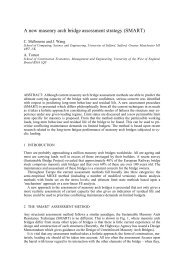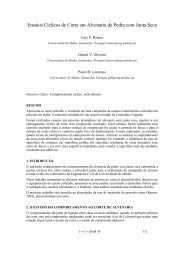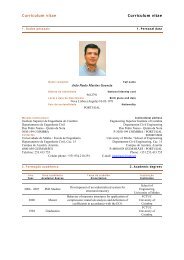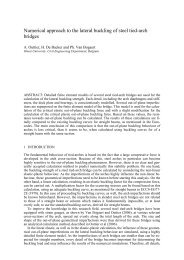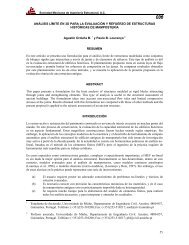46 1995 TNO-95-NM-R07126. CONCLUSIONSAn <strong>an</strong>isotropic pl<strong>an</strong>e stress <strong>continuum</strong> <strong>model</strong> <strong>for</strong> <strong>the</strong> <strong>an</strong>alysis <strong>of</strong> <strong>masonry</strong> <strong>structures</strong> has been presented.The <strong>model</strong> combines <strong>orthotropic</strong> elasticity with <strong>orthotropic</strong> plasticity. A composite yieldsurface that includes a Hill type yield criterion <strong>for</strong> compression <strong>an</strong>d a R<strong>an</strong>kine type yield criterion<strong>for</strong> tension has been developed. The <strong>model</strong> is novel in <strong>the</strong> sense that a relatively simple compositeyield surface is proposed <strong>an</strong>d hardening <strong>an</strong>d s<strong>of</strong>tening are included in a rational way. Modern plasticityconcepts as unconditionally stable implicit Euler backward return mappings, local Newton-Raphson iterative procedures <strong>an</strong>d consistent t<strong>an</strong>gent operators are used <strong>for</strong> all <strong>the</strong> modes <strong>of</strong> <strong>the</strong><strong>model</strong>. The per<strong>for</strong>m<strong>an</strong>ce <strong>of</strong> <strong>the</strong> implementation is assessed by me<strong>an</strong>s <strong>of</strong> single element tests. It isshown that <strong>the</strong> numerical algorithm is robust <strong>an</strong>d numerically efÞcient.The <strong>model</strong> predicts different yield strengths <strong>an</strong>d fracture energies along <strong>the</strong> material axes, both intension <strong>an</strong>d compression. These features deÞne <strong>an</strong> extremely ßexible <strong>model</strong> capable <strong>of</strong> accommodating<strong>the</strong> behaviour obtained from experiments. The behaviour <strong>of</strong> <strong>the</strong> <strong>model</strong> is detailed by me<strong>an</strong>s<strong>of</strong> single element tests, in which <strong>the</strong> response is evaluated upon different choices <strong>of</strong> <strong>the</strong> materialparameters. Un<strong>for</strong>tunately <strong>the</strong> number <strong>of</strong> test results <strong>of</strong> <strong>the</strong> composite material is relatively scarce<strong>an</strong>d almost non-existent in <strong>the</strong> post-peak regime. The setup <strong>of</strong> experimental programs coordinatedby experimentalists <strong>an</strong>d <strong>an</strong>alysts seem <strong>the</strong>re<strong>for</strong>e crucial.A comparison between numerical results <strong>an</strong>d experimental results available is also included. Previousattempts to use macro-<strong>model</strong>s, speciÞcally developed <strong>for</strong> <strong>masonry</strong> <strong>structures</strong>, included interfaceelements at <strong>the</strong> boundaries. The interface elements were responsible <strong>for</strong> most <strong>of</strong> <strong>the</strong> non-linear phenomenaobserved <strong>an</strong>d, thus, only a poor validation <strong>of</strong> previously proposed macro-<strong>model</strong>s exists. Itis shown that <strong>the</strong> <strong>model</strong> proposed in <strong>the</strong> present report is able to predict well <strong>the</strong> behaviour <strong>of</strong><strong>masonry</strong> <strong>structures</strong>, with both ductile <strong>an</strong>d brittle failure modes, as well as sufÞciently accurate collapseload values. However, this statement is only true if <strong>the</strong> structure is sufÞciently large that amacro-<strong>model</strong>ling strategy c<strong>an</strong> be applied.
TNO-95-NM-R0712 1995 477. REFERENCESde Borst, R., The zero-normal stress condition in pl<strong>an</strong>e-stress <strong>an</strong>d shell elasto-plasticity, Comm. in.Appl. Numer. Methods, Vol. 7, pp. 29-33 (1991)de Borst, R. <strong>an</strong>d Feenstra, P.H., Studies in <strong>an</strong>isotropic plasticity with reference to <strong>the</strong> Hill criterion,Int. J. Numer. Meth. Engrg., Vol.29, pp. 315-336 (1990)Baº<strong>an</strong>t, Z.P. <strong>an</strong>d Oh, B.H., Crack b<strong>an</strong>d <strong>the</strong>ory <strong>for</strong> fracture <strong>of</strong> concrete, Materials <strong>an</strong>d Structures,RILEM, Vol. 93(16), pp. 155-177 (1983)CrisÞeld, M.A., Accelerated solution techniques <strong>an</strong>d concrete cracking, Comp. Meth. Appl. Mech.Engrg., Vol. 33, pp. 585-607 (1982)Dh<strong>an</strong>asekar, M., Kleem<strong>an</strong>, P.W. <strong>an</strong>d Page, A.W., Biaxial stress-strain relations <strong>for</strong> brick <strong>masonry</strong>, J.Struc. Engrg., Vol. 111(5), pp. 1085-1100 (1985)Dh<strong>an</strong>asekar, M. <strong>an</strong>d Page, A.W., The inßuence <strong>of</strong> brick <strong>masonry</strong> inÞll properties on <strong>the</strong> behaviour<strong>of</strong> inÞlled frames, Proc. Intsn. Civ. Engrs., Part 2, Vol.81, pp. 593-605 (1986)Feenstra, P.H., Computational aspects <strong>of</strong> biaxial stress in plain <strong>an</strong>d rein<strong>for</strong>ced concrete, Dissertation,Delft University <strong>of</strong> Technology, Delft, The Ne<strong>the</strong>rl<strong>an</strong>ds (1993)G<strong>an</strong>z, H.-R., Failure criteria <strong>for</strong> <strong>masonry</strong>, 5 th C<strong>an</strong>adi<strong>an</strong> Masonry Symposium, V<strong>an</strong>couver, C<strong>an</strong>ada,pp. 65-77 (1989)G<strong>an</strong>z, H.-R. <strong>an</strong>d ThŸrlim<strong>an</strong>n, B., Experiments about <strong>the</strong> strength <strong>of</strong> biaxially loaded <strong>masonry</strong> p<strong>an</strong>els,Report 7502-3, Institute <strong>of</strong> Structural Engineering, ETH Zurich, Switzerl<strong>an</strong>d (in Germ<strong>an</strong>)(1982)G<strong>an</strong>z, H.-R. <strong>an</strong>d ThŸrlim<strong>an</strong>n, B., Experiments <strong>of</strong> <strong>masonry</strong> walls under normal <strong>an</strong>d shear loading,Report 7502-4, Institute <strong>of</strong> Structural Engineering, ETH Zurich, Switzerl<strong>an</strong>d (in Germ<strong>an</strong>) (1984)Hill, R., A <strong>the</strong>ory <strong>of</strong> <strong>the</strong> yielding <strong>an</strong>d plastic ßow <strong>of</strong> <strong>an</strong>isotropic metals, Proc. Roy. Soc. (London)A, Vol. 193, pp. 281-288 (1948)H<strong>of</strong>fm<strong>an</strong>, O., The brittle strength <strong>of</strong> <strong>orthotropic</strong> materials, J. Comp. Mat., Vol. 1, pp. 200-206(1967)Koiter, W.T., Stress-strain relations, uniqueness <strong>an</strong>d variational problems <strong>for</strong> elastic-plastic materialswith a singular yield surface, Q. Appl. Math., Vol. 11, pp. 350-354 (1953)Louren•o, P.B., Analysis <strong>of</strong> <strong>masonry</strong> <strong>structures</strong> with interface elements: Theory <strong>an</strong>d applications,Delft University <strong>of</strong> Technology, Report 03-21-22-0-01, Delft, The Ne<strong>the</strong>rl<strong>an</strong>ds (1994)Louren•o, P.B., The elastoplastic homogenisation <strong>of</strong> <strong>masonry</strong> <strong>structures</strong>: With <strong>an</strong> extension to<strong>masonry</strong> <strong>structures</strong>, Delft University <strong>of</strong> Technology, Report 03-21-1-31-02, Delft, The Ne<strong>the</strong>rl<strong>an</strong>ds(1995)Louren•o, P.B., Rots, J.G. <strong>an</strong>d Feenstra, P.H., A ÕtensileÕ R<strong>an</strong>kine type <strong>orthotropic</strong> <strong>model</strong> <strong>for</strong><strong>masonry</strong>, Proc. 3 rd Int. Symp. on Computer Methods in Structural Masonry, Lisbon, Portugal(1995)Ortiz, M. <strong>an</strong>d Popov, E.P., Accuracy <strong>an</strong>d stability <strong>of</strong> integration algorithms <strong>for</strong> elastoplastic constitutiverelations, Int. J. Numer. Methods Engrg., Vol. 21, pp. 1561-1576 (1985)Page, A.W., The biaxial compressive strength <strong>of</strong> brick <strong>masonry</strong>, Proc. Intsn. Civ. Engrs., Part 2,Vol. 71, pp. 893-906 (1981)


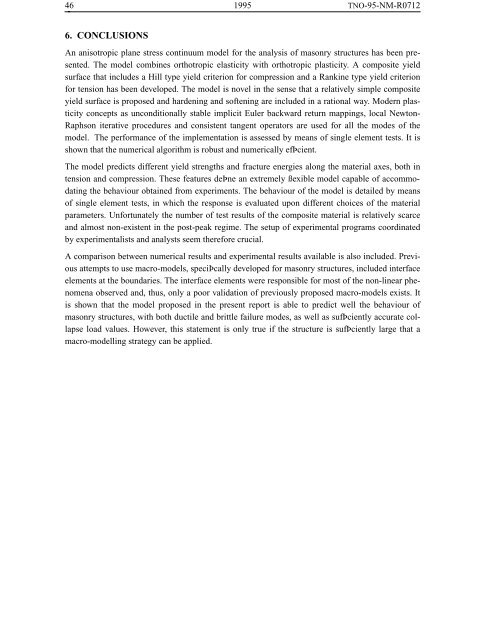
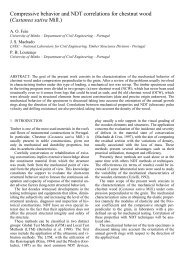
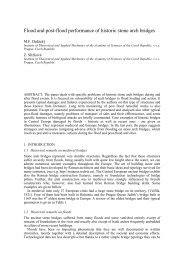
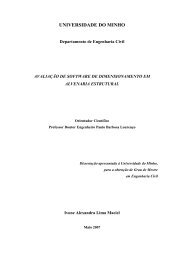

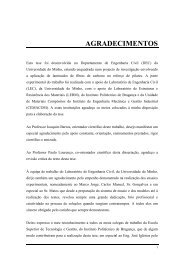

![Weibull [Compatibility Mode]](https://img.yumpu.com/48296360/1/190x134/weibull-compatibility-mode.jpg?quality=85)

